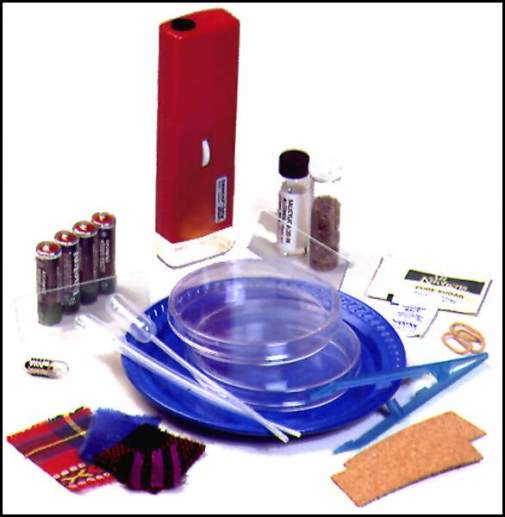We use cookies to make your experience better. To comply with the new e-Privacy directive, we need to ask for your consent to set the cookies. Learn more.
Microscope Explorations Unit
Items in this section tend to be instructional frameworks, or unit studies with a "core" teaching resource supplemented with additional text and/or activity resources.
Maybe we should send this one giftwrapped! Your children will think they've received a wonderful, exciting present when they open this box. Cleverly disguised as intriguing and fun activities, this hat-trick of unit studies (astronomy, birds, and magnetism) will provide a semester's worth of purely educational entertainment. When my son caught sight of the review sample, he literally begged to get started right away. Everything you need is included (except for scissors and a liter soda bottle) - down to the Dixie cups! No more excuses to set aside those interesting experiments because you didn't plan ahead. No more frustration because an item you thought you had wasn't there when you went to retrieve it. And no more crestfallen faces when the "best part" of science (the hands-on part) can't be done that day.
At the heart of this wonderful program, though, is the unit study itself. After you finish "ooohing and aaahing" over the supplies, you'll be happy to discover that the written material is every bit as impressive. There are over a hundred pages of student worksheets, parent guide, keys, and more advanced questions. The parent guide has teacher notes, safety concerns (if applicable), key, and further explorations for each of the lessons in the study. Lessons are self-contained, interesting, and very well laid out. Each centers around an exploratory activity, so children do science, instead of just reading about it.
The Birds unit includes an Identification Guide to Common Backyard Birds, a publication with full- color photographs published by the Bird Watcher's Digest Press. This same unit provides several well-conceived Bird Identification Sheets so children can keep a journal of the birds they spot. Lessons are extremely clear and easy to follow, complete with diagrams, charts, and illustrations as needed. Children over 3rd grade should be able to use the lessons by themselves, if necessary. Lesson sheets are hole-punched so you can put them in a student notebook. These sheets can be reproduced for other children in the same family only. The included binoculars have been recently upgraded from children's binoculars to glass-lensed 8 x 21 binoculars.
After using the triple set in our own homeschool, we are even more enthused about it. Mark really enjoyed the lessons and equipment, and looked forward to doing the lessons - it was a high point of his day. It's so easy for me to use, with very minimal preparation, and everything is there when I need it. The directions are so clear and easy to follow, Mark was often able to do them himself with minimal supervision or just my follow-up. The emphasis on doing science is a real plus, also, as Mark has plenty of writing in his other coursework. The student worksheets require short written responses, or the recording of data from experiments, which is just fine with him. I highly recommend this set of unit studies - especially for busy moms! We're not the only ones that love them; Cathy Duffy recommends these kits in her 100 Top Picks for Homeschool Curriculum. Materials in the kit can be shared by two students.
This second "triple" set contains Microscopic Explorations, Discovering Insects and The Wonders of Light.
The Microscope Explorations unit explores the basics of using the microscope as children investigate plants, animals, fungi and protozoa, as well as crystals and crystal formation. An easy-to-use Tasco pocket microscope is included with the fourteen lessons and parent guide, along with everything else you need to do the lessons, except an onion and a slice of bread. The materials contain over 30 experiments and should provide about six-weeks of hands-on science. There is enough consumable equipment for several children working together to share. Extra pocket microscopes are available.
The Wonders of Light unit looks fascinating, also. From mirrors to rainbows, polarization to phosphorescence, these 16 lessons (with over 30 experiments) explore one of the most fascinating and basic of God's creations. As with other units from this company, the lessons are extremely well laid-out, the parent's guide makes it easy to just open the box and go, and everything you need to do the lessons is provided. Who could ask for more?
Beginning with "Spiders Don't Have Wings (Thank Goodness!)," Discovering Insects explores the amazing world of the insect (yes, they cover that the spider is not an insect). Twelve lessons are filled with hands-on activities, observations, and experiments. Can you find an ant trail? (If not, come to my house!) Janine and Mark are "itching" (did someone mention fleas?) to start this one.
| Product Format: | Kit |
|---|---|
| Brand: | Stratton House |
| Grades: | 1-8 |
| Length in Inches: | 13.25 |
| Width in Inches: | 10 |
| Height in Inches: | 2.25 |
| Weight in Pounds: | 1.125 |

